Keikis are young orchid plantlets, usually produced from old plant stock with low yield, to be used as new seedling stock for the next generation of nursery plants. Keikis retains similar genetics makeup from the parent plant and are more stable than mericlone in terms of genetics stability for the next generation of stock plants. Producing keikis from old orchid plants is a very simple process. In this entry, we will describe and share the methods we use for producing keikis for two varieties of orchids, namely the Dendrobium and Mokara.
For Dendrobium, select old mature parent plants with low flowering yields. For best results, choose those with thick, turgid and succulent stems and exclude the rest with skimpy stems.
To be neater, the parent plant may be separated into individual stems as shown above, or left as a whole as shown below. Remove their leaves and trim the stem down to manageable size. Treat the stems with fungicide, particularly to areas which were trimmed and have open wounds, before drying the plants out in the sun.
After drying, lay the stems in neat rows, under 50% shade, as shown in the pictures below. Keep watering to minimum and apply fungicide regularly. The main objective here is to induce stress and shock to the parent plants so that they produce more keikis.
Keikis should start growing off primarily at the terminal end of stems within two months. Growth from nodes on stems may also be observed but in lesser quantity.
Towards the second month, fertilizers may be applied when new root growth from the keikis are observed. Keikis should be ready for transplanting within two to three months after the hardening process.
To transplant the keikis, use a clean shear and snipe off the attached keikis off the old parent stem. Note that the bulb of the new plantlet should not be damaged in the process.
Transplant the detached keiki in fresh charcoal and with care, it will eventually grow into a new orchid plant similar to its parent plant.
The method for producing keikis from Mokara is different from that of Dendrobiums. This similar method applies for most tropical Vandaceous plants which includes plants like the Aranda, Ascocenda, Aranthera and so on.
To produce keikis from the Mokara, start by performing a top cut by cutting the entire parent plant in half (usually the top portion will be about 2/3 of the parent plant and the bottom will be about 1/3 of the parent plant, for shorter plants, they are cut into 1/2 for top and 1/2 bottom), thus removing the apical bud/meristem/shoot from the parent plant.
Treat the two portions with fungicide, particularly to the open wounds region. The top cut portion of the parent plant can be immediately replanted as a new plant. The remaining stump of the plant can then be used for inducing keikis.
Unlike the Dendrobiums, fertilization program for the stump portion of the Mokara should still continue as per norm. Setup the parent stump in 50% shade and keikis will grow from the axillary buds/nodes, which are usually found at the joints of the remaining leaves and stem, as shown in the picture on the right.
Theoretically, all the remaining nodes are capable of producing one keiki each, thus when the keiki hardens and produces root, it will be good to snipe them off if you would like more keikis to be produced. This would relieve the parent stump of its load and new keikis may be produced if there are still nodes remaining. This process will be good for about 6 months, after of which the keikis production will retard after the parent stump has drained most of it resources.
The keikis produced will gradually grow into plants similar to the parent plant.


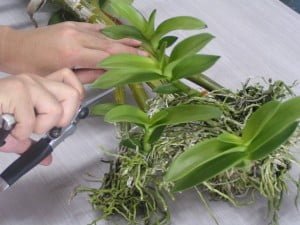
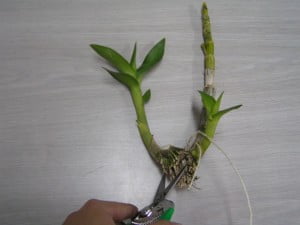
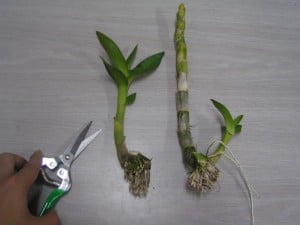
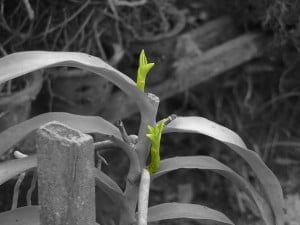
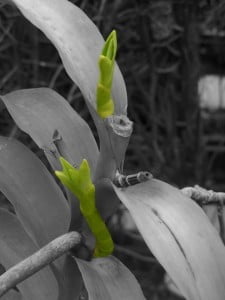
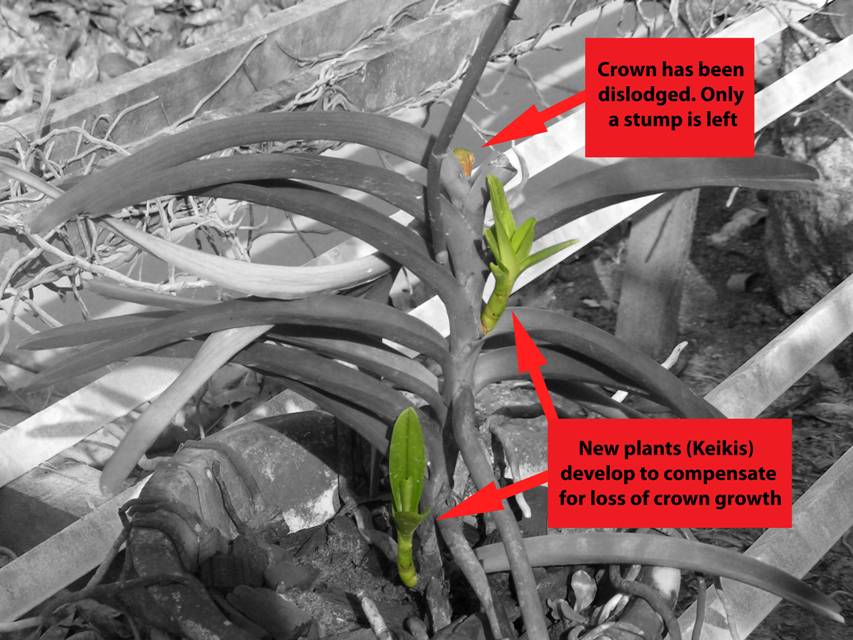

nice article, keep the posts coming
thanks! I’ll try to =)
FANTASTIC ARTICLE !!!!! please . . . . MORE !!!!!
Dear Friend,
Is it good to apply any hormones for producing keikies
pl reply.
Chennilode
Dear Chennilode,
Yes, it is possible to apply hormones for producing keikis however we do not really recommend usage of hormones for inducing keikis.
silverelf
Dear silverelf ,
Thank you for your reply and pictures.
Raveendran Chennilode
Dear Silverelf,
I purchased your EZ Grow fertilizer at the WOC and have since been watering & feeding my dens properly thanks to your advice. One of my orchids appears to have a keiki growing at the top (I can see roots growing from the bottom of the new stem). Can I leave it there or should I transplant it?
Dear Carie,
Its ok to leave the keiki growing at the top. Once it starts developing green roots, you can remove and transplant it. This will allow the keiki to establish faster when its transplanted.
silverelf
Does the parent plants die in the process or do they grow their leaves back?
Hi Breezy,
The parent plant will continue to produce keikis and shrivel up in the process.
silverelf
Very generous information, and the best website about growing and caring orchids. Your sites clearly explained the instruction with included photos,unlike other sites youll just get bored and learn nothing.Keep up the good work
Dear Gary,
Thanks for the compliment! 🙂
silverelf
Hi silferelf,very good info because I did not know where to cut my mokara .Love that you put the pics etc,keep up the good work,merry x-mas
Dear Sara,
Thank you for your compliment.
silverelf
Thanks for the advise.I did follow the instructions and now i am having new plants just like their mothers
How long do you dry the dendrubium stems in the sun for producing keikis? What brand of insectisides and fungicide do you suggest for use? Thanks for the orchid info, nice read.
Hi Rey,
It will take around 3 to 6 months to produce the keikis. Dry the stem under 50% sun.
We use different kind of insecticide and fungicide on rotational basis.
For insecticide (e.g. imidacloprid), fungicide (e.g. thiram).
silverelf
Hi Silverelf, great site, very informative info. I have a Vanda orchid now 6 yrs was mature and blooming when I got it. This spring it has produced 3 keikis. 2 are at the crown and 1 at the base near a large root. None of the keikis have developed their own roots. What would you suggest? I must tell you the mother plant has bloomed again, but I also moved to a new home and the plant is in a new location. To me my vanda looks healthy. Again looking for guidence.
Hi Denise,
Its okay to leave the keikis to grow bigger first.
It won’t affect the mother plant much.
When they start producing their own roots, you can start the transplanting process.
Hi Silverelf–Great article and thx–my question is-once the keiki is cut for a new plant,how long till it produces flowers?
Informative articles. Is there any chances to visit and work at the garden? I really want to work on it. Thanks.
Hi Michael,
It depends on how large your keikis is when you trim them off.
I would say that it will shorten the time by at least 6 – 9 months as compared to growing them from seedlings.
silverelf
Hi bimal,
We do not have vacancies at the moment but you may email your resume to us at [email protected].
Thanks!
silverelf
Hi..I am glad I came across this site..i have two mokaras one is about five years old and i bought it when it was a piece of a plant..treated it and planted it in stone .coals..coconut chips…it has been blooming four years now and last year i got twice…mokara chao…the other i am not sure of the name also bought as a cutting..from reading this post i realized what the person i bought them both from had done so i will follow your instructions but right now they are both in bloom and it looks as though they are both having another spike too…i will let you know further…thanks Silverelf
Hi Brens,
Glad to hear from you!
Looks like your Mokaras are doing well. =)
There are a number of Mokara Chao Praya hybrids with different bright colours.
Most of them are very easy to flower.
(E.g. Mokara Chao Praya Boy, Mokara Chao Praya Sunset)
silverelf
Hi, silverelf. Recently I bought an orchid plant at Giant supermarket as one of the bloomed flower has pretty colour (other buds are still not bloom). I think it’s dendrobium. Here’s the link to all the pictures http://pho.to/9ZW5P
As this is my first time to own an orchid plant, I’m still not sure of what kind of fertilizer to use. I went to a shop near my house, they recommended me to use “Orchid Hormone” by Horti. There are 2 young plants in the pot as well, one seems healthy, but the other doesn’t seem so healthy as some part of the leaf slightly yellowish and its stem wrinkled (there’s a picture of it in the link I pasted above). And also, as you can see, there are 2 new shoot growing.
There are some black spots on the leaves and also the main plant stem. I applied hydrogen peroxide by using cotton bud on those spots as I searched on youtube, many of the orchid owners use it to sterilise their orchid.
I hope you can give me some advice on these matters. Thank you!
Dear Ferra,
Congrat! Your plant looks very healthy in general.
Generally, we feed our orchids two type of fertilizers, Ezi Gro NPK 24:17:17 or Ezi Gro NPK 21:21:21 and Ezi Gro NPK 13.5:27:27.
These are commercial fertilizers that we formulated ourselves and are applied in large nurseries.
Generally, the fertilizers are generally colour coded, the blue or green coloured ones are use for feeding purposes and the red or pink one is for flowering purposes.
The black spots are generally due to sun burnts or mechanical damages, however, its okay for our local cane Dendrobiums to shed their bottom leaves, its normal.
You can use hydropgen peroxide to sterile open wounds on the orchid cuttings to prevent bacterial or fungal growth.
For more info, read up our dendrobium orchid care section here: http://tohgarden.com/orchid-care/dendrobium/
silverelf
Dear silverelf,
I have the following orchids.
Phalaenopsis, oncidium.kazumic, Epi-floribundum.
Pl. advise me , Which method to follow for these to produce kiekies. Your advises are very useful to beginners, especially. Thank you very much.
– Srinivasulu
Dear Srinivasulu,
For Oncidium the method for producing keikis is similar to Dendrobium.
For Phalaenopsis and Epidendrum, keikis can be reproduce similar to the Dendrobium method or reproduced from the flower stems as well.
Generally it is faster to reproduce keikis from the flower stems for Phalaenopsis.
silverelf
[…] http://tohgarden.com/others/producing-keikis/ […]
enjoyed reading ur answers to the queries from different people .really helped me a lot to grow orchids in my balcony.thanks .
Though I have several types of Dendrobium, cattleya, vanda, and phaleanopsis orchids and have been growing them for years I still consider myself to be new.
I love how informative year site is! If ever I have a question about one of my babies I am always able to find it here! Thank you!😊
Sir
Wish to know more about fertilization
Dendrobium small plants and flowering plants
Thank you
Hi Krish,
Check out our orchid care section here.
https://tohgarden.com/orchid-care/fertilizers/
silverelf